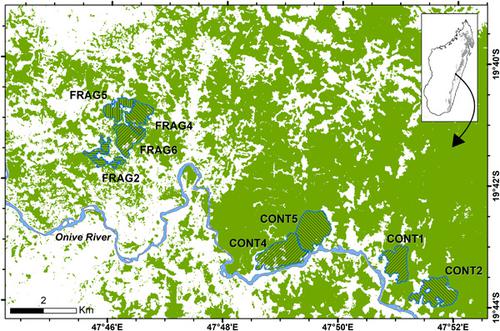当前位置:
X-MOL 学术
›
Am. J. Primatol.
›
论文详情
Our official English website, www.x-mol.net, welcomes your feedback! (Note: you will need to create a separate account there.)
Condensed tannins in the diet of folivorous diademed sifakas and the gap between crude and available protein
American Journal of Primatology ( IF 2.4 ) Pub Date : 2021-02-05 , DOI: 10.1002/ajp.23239 Emma G Thurau 1, 2, 3 , Andry Narcisse Rahajanirina 4, 5 , Mitchell T Irwin 5, 6
American Journal of Primatology ( IF 2.4 ) Pub Date : 2021-02-05 , DOI: 10.1002/ajp.23239 Emma G Thurau 1, 2, 3 , Andry Narcisse Rahajanirina 4, 5 , Mitchell T Irwin 5, 6
Affiliation

|
Tannins, a type of plant secondary metabolite, are well‐known for their ability to precipitate proteins and thereby reduce the protein available to consumers. Most primate studies have focused on condensed tannins (CTs) as they were thought to be the most effective type of tannin at preventing protein acquisition, but there is growing recognition that other types of tannins can bind to proteins, suggesting the division among tannin types is not as clear‐cut as previously thought. Although previous studies have documented the presence of CTs in primate diets and primates' behavioral responses to them, our understanding of tannins remains limited because few researchers have used Sephadex column purification to accurately determine tannin concentrations, and few have used in vitro assays to determine available protein content and the tannins' effectiveness in binding protein. In this study, we documented diademed sifaka (Propithecus diadema) diet from June to August 2018 at Tsinjoarivo, Madagascar (in two forests with varying degrees of habitat disturbance) and quantified CT concentration and actual available protein in foods. Eleven of the fourteen top foods tested contained CTs (concentrations: 4.8%–39.3% dry matter). An in vitro assay showed available protein was strikingly low in six of the eleven top foods (e.g., little to no apparent available protein, despite high crude protein). Overall, our findings suggest sifakas acquire less protein than previously recognized and probably have adaptations to counteract tannins. Such studies of available protein are critical in understanding dietary constraints on sifaka populations and the evolution of their diet choice strategies; despite the conventional wisdom that leaves are protein‐rich, folivorous primates may indeed be protein‐limited. However, further studies are necessary to determine if sifakas have counter‐adaptations to tannins, and if they absorb more protein than our analyses suggest, perhaps receiving protein that we were unable to detect with the current techniques (e.g., pollen).
中文翻译:

食叶金刚鹦鹉饮食中的浓缩单宁以及粗蛋白和可用蛋白质之间的差距
单宁是一种植物次级代谢产物,以其沉淀蛋白质的能力而闻名,从而减少了消费者可获得的蛋白质。大多数灵长类动物研究都集中在缩合单宁 (CT) 上,因为它们被认为是阻止蛋白质获取最有效的单宁类型,但越来越多的人认识到其他类型的单宁可以与蛋白质结合,这表明单宁类型之间的划分是不像之前想象的那么清晰。尽管之前的研究已经记录了灵长类食物中 CT 的存在以及灵长类动物对它们的行为反应,但我们对单宁的了解仍然有限,因为很少有研究人员使用 Sephadex 柱纯化来准确确定单宁浓度,也很少使用体外分析来确定可用的单宁。蛋白质含量和单宁 结合蛋白的有效性。在这项研究中,我们记录了金刚鹦鹉(长尾猿) 2018 年 6 月至 8 月在马达加斯加 Tsinjoarivo 的饮食(在两个栖息地受到不同程度干扰的森林中),并量化了食物中的 CT 浓度和实际可用蛋白质。测试的 14 种顶级食物中有 11 种含有 CT(浓度:4.8%–39.3% 干物质)。一项体外分析表明,在十一种顶级食物中的六种中,可用蛋白质的含量惊人地低(例如,尽管粗蛋白含量很高,但几乎没有或没有明显的可用蛋白质)。总的来说,我们的研究结果表明 sifakas 获得的蛋白质比以前认识的要少,并且可能具有抵消单宁的适应性。此类对可用蛋白质的研究对于了解对蚕种群的饮食限制及其饮食选择策略的演变至关重要;尽管传统观点认为叶子富含蛋白质,食叶灵长类动物可能确实是蛋白质有限的。然而,需要进一步的研究来确定 sifakas 是否对单宁有反适应性,以及它们是否吸收了比我们的分析所建议的更多的蛋白质,也许接受了我们目前技术无法检测到的蛋白质(例如花粉)。
更新日期:2021-02-23
中文翻译:

食叶金刚鹦鹉饮食中的浓缩单宁以及粗蛋白和可用蛋白质之间的差距
单宁是一种植物次级代谢产物,以其沉淀蛋白质的能力而闻名,从而减少了消费者可获得的蛋白质。大多数灵长类动物研究都集中在缩合单宁 (CT) 上,因为它们被认为是阻止蛋白质获取最有效的单宁类型,但越来越多的人认识到其他类型的单宁可以与蛋白质结合,这表明单宁类型之间的划分是不像之前想象的那么清晰。尽管之前的研究已经记录了灵长类食物中 CT 的存在以及灵长类动物对它们的行为反应,但我们对单宁的了解仍然有限,因为很少有研究人员使用 Sephadex 柱纯化来准确确定单宁浓度,也很少使用体外分析来确定可用的单宁。蛋白质含量和单宁 结合蛋白的有效性。在这项研究中,我们记录了金刚鹦鹉(长尾猿) 2018 年 6 月至 8 月在马达加斯加 Tsinjoarivo 的饮食(在两个栖息地受到不同程度干扰的森林中),并量化了食物中的 CT 浓度和实际可用蛋白质。测试的 14 种顶级食物中有 11 种含有 CT(浓度:4.8%–39.3% 干物质)。一项体外分析表明,在十一种顶级食物中的六种中,可用蛋白质的含量惊人地低(例如,尽管粗蛋白含量很高,但几乎没有或没有明显的可用蛋白质)。总的来说,我们的研究结果表明 sifakas 获得的蛋白质比以前认识的要少,并且可能具有抵消单宁的适应性。此类对可用蛋白质的研究对于了解对蚕种群的饮食限制及其饮食选择策略的演变至关重要;尽管传统观点认为叶子富含蛋白质,食叶灵长类动物可能确实是蛋白质有限的。然而,需要进一步的研究来确定 sifakas 是否对单宁有反适应性,以及它们是否吸收了比我们的分析所建议的更多的蛋白质,也许接受了我们目前技术无法检测到的蛋白质(例如花粉)。


























 京公网安备 11010802027423号
京公网安备 11010802027423号